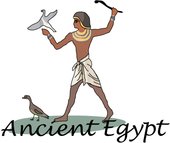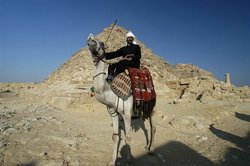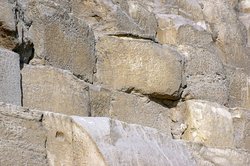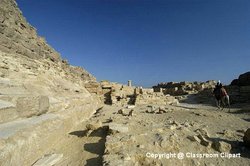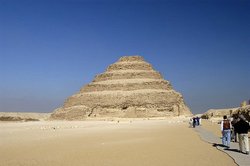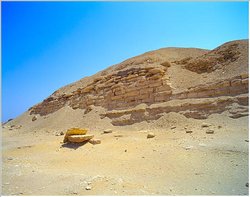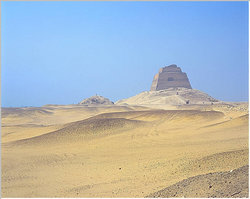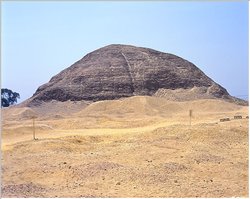Egyptian pyramids
|
|
The pyramids of Egypt, some of which are among the largest man-made constructions ever conceived [1] (https://academickids.com:443/encyclopedia/index.php/Egyptian_pyramids#fn_pyramids_large_structures), constitute one of the most potent and enduring symbols of Ancient Egyptian civilization. Despite a Pharaoh never having ever been found buried in an Egyptian pyramid, it is generally accepted by most archaeologists that they were constructed as burial monuments associated with royal solar and stellar cults, and most were built during the Old and Middle Kingdom periods[2] (https://academickids.com:443/encyclopedia/index.php/Egyptian_pyramids#fn_when_pyramids_built). Egyptian homes were built on the east bank of the river, the land where the Sun rises. Egyptians built the pyramids on the west bank of the River Nile. They believed this was the land of the dead, because the Sun set there.[3] (https://academickids.com:443/encyclopedia/index.php/Egyptian_pyramids#fn_west_bank_hell)
| Contents |
Historic development
By the time of the early Dynastic period of Egyptian history, those with sufficient means were buried in visually unremarkable bench-like structures[4] (https://academickids.com:443/encyclopedia/index.php/Egyptian_pyramids#fn_mastaba_bench) known as mastabas.[5] (https://academickids.com:443/encyclopedia/index.php/Egyptian_pyramids#fn_mastabas_for_rich)
The first historically documented Egyptian pyramid is attributed to the architect Imhotep[6] (https://academickids.com:443/encyclopedia/index.php/Egyptian_pyramids#fn_Imhotep_first_pyramid), who in constructing what Egyptologists believe to be a tomb for the pharaoh Djozer, it is theorized first conceived the notion of stacking a number of mastabas on top of each other — thereby creating an edifice comprised of a number of steps that decreased in size towards its apex. The result was the Step Pyramid of Djozer — which was designed to serve as a gigantic stairway by which the soul of the deceased pharaoh could ascend to the heavens. Such was the importance of Imhotep's achievement that he was deified by later Egyptians.[7] (https://academickids.com:443/encyclopedia/index.php/Egyptian_pyramids#fn_Imhotep_deified). Given Egyptologists also credit Djozer with the construction of the impressive "Bent" and "Red" pyramids, it is not understood why if Egyptian pyramids were built as "tombs and tombs only" as Egyptologists believe it would be necessary for one pharoah to have constructed three.
The most prolific pyramid-building phase coincided with the greatest degree of absolutist pharaonic rule, during the early part of the Old Kingdom. Over time, as the exercise of pharaonic authority became less centralised and more bureaucratised, the ability and willingness to harness the resources required for construction on a massive scale was reduced, and later pyramids were smaller, less well built and often hastily constructed.
Long after the end of Egypt's own pyramid-building period, a burst of pyramid-building occurred in what is present-day Sudan, after much of Egypt came under the rule of the Kings of Napata. Whilst Napatan rule was brief and ceased in 661 BC, the Egyptian influence had made an indelible impression, and during the later Sudanese Kingdom of Meroe (approximately in the period between 300 BC–AD 300) this flowered into a full-blown pyramid-building revival, which saw more than two hundred uniquely indigenous, but strongly Egyptian-inspired royal pyramid tombs constructed in the vicinity of the Meroitic capital city.
Construction techniques
The techniques used to construct Egypt's pyramids may have initially been developed by trial and error[8] (https://academickids.com:443/encyclopedia/index.php/Egyptian_pyramids#fn_trial_and_error), and then further evolved based on local economics, resources, and other considerations, over the thousand year pyramid-building phase of Egyptian civilization.
Make note that contrary to popular belief, scholars do not believe that the pyramids of Egypt were built by the Jewish slaves. Scholars doubt that there were built by slaves at all. The Jews came probably during the 18th Dynasty in the new Kingdom and by then Pyramid building was a thing of the far past. Recently we have found tombs of the workers, they show us in how they are made, how important (so to speak) a person was, the pyramid workers were paid craftsmen, not slaves they had their own city at Giza.
During the earliest period, in the Third and Fourth Dynasties, pyramids were constructed wholly of stone. Granite (quarried in Aswan and transported downstream by barge) was usually the material of choice for the main body of these pyramids, while limestone was used as the outer casing. In early pyramids, the courses of stone forming the pyramid body were laid sloping inwards; however, this configuration was found to be less stable than simply stacking horizontal courses on top of each other. The Bent Pyramid at Dahshur represents the transition between these two building techniques; its lower section is built of sloping courses, while in its upper section the stones are laid horizontally.
During the Fifth Dynasty the physical scale of pyramids was much reduced, and poor quality limestone replaced granite as the chief building material. Infilling with loose rubble was also used for the first time. This enabled pyramids to be built with fewer resources over much shorter periods.
During the Middle Kingdom pyramid construction techniques changed again. Most pyramids built at this time were little more than mountains of mud brick encased in a veneer of polished limestone. In several cases, later pyramids were built on top of natural hills to further reduce the volume of material needed in their construction.
Paradoxically, the materials and methods of construction used in the earliest pyramids have ensured their survival in a generally much better state of preservation than is the case with the pyramid monuments of later pharaohs.
Pyramid sites
The number of pyramid structures in Egypt today is reported by most sources as being between 80 and 110, with a majority favouring the higher number. The reason for the imprecise nature of the count appears related to the fact that as many smaller pyramids are in a poor state of preservation and appear as little more than mounds of rubble, they are only now being properly identified and studied by archaeologists. Most are grouped in a number of pyramid fields, the most important of which are listed geographically, from north to south, below.
Abu Rawash
Abu Rawash is the site of Egypt's most northerly pyramid[9] (https://academickids.com:443/encyclopedia/index.php/Egyptian_pyramids#fn_Rawash_northerly) other than the ruins of Lepsius pyramid number one[10] (https://academickids.com:443/encyclopedia/index.php/Egyptian_pyramids#fn_Rawash_ruins_lepsius)— the mostly ruined Pyramid of Djedefre, the son and successor of Khufu. Originally it was thought that this pyramid had never been completed, but the current archaelogicical consensus is that not only was it completed, but that it was originally about the same size as the Pyramid of Menkaure — the third largest of the Giza pyramids. On this basis Djedefre's edifice would have claimed the title of the fourth or fifth largest pyramid in Egypt.
Unfortunately its location adjacent to a major crossroads made it an easy source of stone, and quarrying — which began in Roman times — continued until as recently as the early 20th century. Today little remains apart from a few courses of stone superimposed upon the natural hillock that formed part of the pyramid's core — although a small adjacent satellite pyramid is in a better state of preservation.
Giza
Main article: Giza pyramid complex
Giza, on the southern outskirts of Cairo is the location of the Pyramid of Khufu (also known as the "Great Pyramid" and the "Pyramid of Cheops"), the somewhat smaller Pyramid of Khafre (or Kephren), and the relatively modest-sized Pyramid of Menkaure (or Mykerinus), along with a number of smaller satellite edifices, known as "queens" pyramids, and the Great Sphinx.
Of the three, only Khafre's pyramid retains part of its original polished limestone casing, towards its apex. Interestingly this pyramid appears larger than the adjacent Khufu pyramid by virtue of its more elevated location, and the steeper angle of inclination of its construction — it is, in fact, smaller in both height and volume.
The Giza Necropolis has arguably been the world's most popular tourist destination since antiquity, and was popularised in Hellenistic times when the Great Pyramid was listed by Antipater of Sidon as one of the Seven Wonders of the World. Today it is the only one of the ancient Wonders still in existence.
Zawyet el-Aryan
This site, half way between Giza and Abu Sir, is the location for two unfinished Old Kingdom pyramids. The northern structure's owner is believed to be the Pharaoh Nebka, whilst the southern structure is attributed to the Third Dynasty Pharaoh Khaba, also known as Hudjefa, successor to Sekhemket). Khaba's four-year tenure as pharaoh more than likely explains the similar premature truncation of his step pyramid. Today it is approximately twenty metres in height; had it been completed it is likely to have exceeded forty.
Abu Sir
There are a total of seven pyramids at this site, which served as the main royal necropolis during the Fifth Dynasty. The quality of construction of the Abu Sir pyramids is inferior to those of the Fourth Dynasty — perhaps signaling a decrease in royal power or a less vibrant economy. They are smaller than their predecessors, and are built of low quality local limestone.
The three major pyramids are those of Niuserre (which is also the most intact), Nferirkare and Sahure. The site is also home to the incomplete Pyramid of Neferefre. All of the major pyramids at Abu Sir were built as step pyramids, although the largest of them — the Pyramid of Nferirkare — is believed to have originally been built as a step pyramid some seventy metres in height and then later transformed into a "true" pyramid by having its steps filled in with loose masonry.
Saqqara
Major pyramids at Saqqara include the Step Pyramid of Djozer — the world's oldest monumental stone building — the Pyramid of Userkaf and the Pyramid of Teti. Also at Saqqara is the Pyramid of Unas, which retains a pyramid causeway that is amongst the best-preserved in Egypt. This pyramid was also the subject of one of antiquities' earliest restoration attempts, conducted under the auspices of one of the sons of Ramses II. Saqqara is also the location of the incomplete step pyramid of Djozer's successor Sekhemkhet. Archaeologists believe that had this pyramid been completed it would have been larger than Djozer's.
Dahshur
Dahshur is arguably the most important pyramid field in Egypt outside Giza and Saqqara, although until recently the site was inaccessible due to its location within a military base, and hence was virtually unknown outside archaeological circles.
The southern Pyramid of Sneferu, commonly known as the Bent Pyramid is believed to be the first (or by some accounts, second) attempt at creating a pyramid with smooth sides. In this it was only a partial — but nonetheless visually arresting — success; it remains the only Egyptian pyramid to retain a significant proportion of its original limestone casing, and serves as the best example of the luminous appearance common to all pyramids in their original state.
The northern, or Red Pyramid built at the same location by Sneferu was later successfully completed as the world's first true smooth-sided pyramid. Despite its relative obscurity, the Red Pyramid is actually the third largest pyramid in Egypt — after the pyramids of Khufu and Khafre at Giza. Also at Dahshur is the so-called Black Pyramid of Amenemhet III.
Lisht
Two major pyramids are known to have been built at Lisht — those of Amenemhat I and his son, Senusret I (Sesostris I). The latter is surrounded by the ruins of ten smaller subsidiary pyramids. The site which is in the vicinity of the oasis of Fayyum, midway between Dahshur and Meidum, and about 100 kilometres south of Cairo, is believed to be in the vicinity of the ancient city of Iti-tawi (the precise location of which remains unknown), which served as the capital of Egypt during the 12th Dynasty.
Meidum
The pyramid at Meidum is one of three constructed during the reign of Sneferu, and is believed by some to have been commenced by that pharaoh's father and predecessor, Huni. Some archaelogists also suggest that the Meidum pyramid may have been the first unsuccessful attempt at the construction of a "true" or smooth-sided pyramid.
The pyramid suffered a catastrophic collapse in antiquity, and today only the central parts of its stepped inner core remain standing, giving it an odd tower-like appearance that is unique among Egyptian pyramids. The hill that the pyramid sits atop is not a natural landscape feature — it is in fact the small mountain of debris created when the lower courses and outer casing of the pyramid gave way.
One face of the pyramid at Meidum collapsed and was shorn off around the year 2600BC, during the placement of its outer walls. The Meidum pyramid was a true pyramid, a tetrahedron, whereas Djoser’s pyramid was a step pyramid, made of stacked rectangular mastabas. At the Meidum pyramid, the buttresses were not extended to include the structurally significant outer casing.
This addition of the limestone casing without sideways structural support proved fatal, and massive rubble mounds can still be seen beneath the base of the pyramid today. As the Hyatt-Regency Hotel disaster (Hyatt_Regency_walkway_collapse) taught us in 1981, with any change, you must recalculate the system. The success of Djoser’s pyramid and the failure of the one at Meidum laid out a blueprint followed for the remainder of pyramid construction in Egypt.
It has been suggested that the collapse occurred while construction was underway on the Bent Pyramid at Dahshur (also built by Sneferu), and that this may have been one of the reasons for the design changes implemented during construction of the latter edifice. About 50 meters off the ground, the angle of ascent abruptly changes. Some experts have theorized that the builders of the Bent Pyramid changed their construction techniques after learning of the failure at Meidum. Since there are no known collapses of pyramids built after Meidum, we can surmise that innovations - and the disastrous results when these ideas were not followed - were effective lessons. When a structure fails it does so because of an error in design, and oftentimes this design flaw can be recognized and fixed; pyramids built later than Meidum demonstrate inward slanting of the outer casing. Later architects seem to have understood that the limestone covering of their pyramids held significance in structure as well as aesthetics.
Hawarra
Amenemhet III was the last powerful ruler of the 12th Dynasty, and the pyramid he built at Hawarra, near Faiyum, is believed to post-date the so-called "Black Pyramid" built by the same ruler at Dahshur. It is the Hawarra pyramid that is believed to have been Amenemhet's final resting place.
In common with all Middle Kingdom pyramids it was built almost entirely of mud brick faced with limestone. Most of the stone was later pillaged for use in other buildings — a fate common to almost all of Egypt's pyramids — and today the Hawarra pyramid is little more than an eroded vaguely pyramid-shaped mountain of mud brick.
The huge mortuary temple that originally stood adjacent to this pyramid is believed to have formed the basis of the labyrinth mentioned by such ancient historians as Herodotus, Strabo and Diodorus Siculus, and which is said to have been the model for the labyrinth built by Daedalus for King Minos of Crete to house the Minotaur.
el-Lahun
The pyramid of Senwosret II at el-Lahun is the southernmost pyramid structure in Egypt. Its builders reduced the amount of work necessary to construct it by ingeniously using as its foundation and core a 12 metre high natural limestone hill.
Pyramid symbolism
The shape of Egyptian pyramids is believed to represent the primordial mound from which the Egyptians believed the earth was created. The shape is also thought to be representative of the descending rays of the sun, and most pyramids were faced with polished, highly reflective white limestone, in order to give them a brilliant appearance when viewed from a distance. Pyramids were often also named in ways that made reference to solar luminescence. For example, the true name of the Bent Pyramid at Dahshur was The Southern Shining Pyramid, and that of Senwosret at el-Lahun was Senwosret is Shining.
While it is generally agreed that pyramids were burial monuments, there is continued disagreement on the particular theological principles that might have given rise to them. One theory that has gained a degree of acceptance is that they were designed as a type of "resurrection machine";[11] (https://academickids.com:443/encyclopedia/index.php/Egyptian_pyramids#fn_resurrection_machines) the Egyptians believed that the dark area of the night sky around which the stars appear to revolve was the physical gateway into the heavens, and one of the narrow shafts that extends from the main burial chamber through the entire body of the Great Pyramid points directly towards the centre of this part of the sky. This suggests that the pyramid may have been designed to serve as a means to magically launch the deceased pharaoh's soul directly into the abode of the gods.
Burial and tombs
In Egypt, the dead were originally not mummified. Once the practice began, an individual was placed at his/her final resting place through a set of rituals and protocol. The Egyptian funeral was a ceremony of a set the complex of beliefs and practices used by Egyptian culture with various monuments, prayers, and rituals undertaken in the dead's honor.
See also
External links
- Pyramids of Egypt (http://egyptphoto.ncf.ca/index.htm) – Comprehensive site by an Egyptian archaeology enthusiast that includes spectacular photographs of dozens of pyramids.
- Ancient Authors (http://www.casa.ucl.ac.uk/digital_egypt/hawara/bibliography_old.html#her) – A site that quotes descriptions of the "Labyrinth" of Amenemhet III's pyramid at el-Lahun by various ancient authors.
- Pyramids of Nubia (http://www.narmer.pl/pir/pirnub_en.htm) – A site detailing the major pyramid sites of ancient Nubia (Sudan).
- www.great-pyramid.info (http://www.great-pyramid.info/inhalt/html/me/mstarte.htm) – Photographs and information on Egyptian pyramids.

